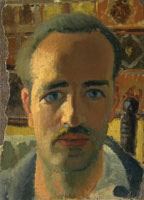
Paul-Émile Borduas
BIOGRAPHY
There is no artist harder to exercise from his time and place than Paul-Émile Borduas. Cloaked in a historical mantle, he has become the symbol of creative rebellion, the masthead of a generation that changed forever the course of Quebec society. His had a romantic, tragic life as he died in exile in Paris. Can one look at Borduas’ paintings and not hear the battle cry of Refus flobal? One can and even should, for his works are as viable and as contemporary as ever. Seen from the perspective of time, they are even more striking.
Borduas’ life shares the timeline with such artists as Salvador Dali, Francis Bacon, Andy Warhol…Although just as original, unique even, as each of these icons, Borduas took a very different route to find and synthesise his style, and his legacy speaks its own language. The Automatist movement he spearheaded pierced like a shaft of light “la grande noirceur”, Quebec’s era of State and Church repression, and branded Borduas a revolutionary.
A heavy, heady responsibility for a thinker and a romantic, a man of frail health. Even heavier for an artist. But while his words ring out loud in the manifesto, his vision can only truly experienced through his art. For in it is not only Borduas – the visionary, Borduas – the painter, but also, profoundly so, Borduas – the – man.
It is apt to quote Hopper again, when he says: “I believe that the great painters with their intellect as master have attempted to force this unwilling medium of paint and canvas into a record of their emotions”. The struggle was just beginning. The blacklash following the publication of Refus global cost Borduas his professional job, but in a way released his genius. From now on, his sole master would be art. He gradually moves away from figurative works, engaging for a while in the exploration of colourful gouaches inspired by Joan Miro. Considered a the time as Surrealist, they were in fact the beginning of a cubist period that would find its full expression in his later canvases.
A summer spent in Provincetown, New England, proved particularly inspirational for the painter. He produced 40 new works, more than in five years in Canada. Oblivious in his creative fervour to the sand and the ocean, he still manages to imbue these paintings with their presence.
Inspired by the light and the “unimaginable totality of space”, he paints shimmering, liquid compositions, in pale, washed out tones.
New York, where he went next, was to be Borduas’ taskmaster. “In New York I started to paint in white, but I have the bizarre impression of never having changed my style, and yet I have passed from figurative to non-figurative. Strange”, he confides in a 1962 NFB documentary by Jacques Godbout. He spends a year in the fascinating city, and at 50, in top creative form, he goes again to Paris. But while in the States Borduas felt European, this time Paris seems alien to him. His later works, these majestic large black and white compositions, are a vast repository of the artist’s pain and isolation. He paints with passion, and in the spring of 1959, has his first solo exhibition in Paris, organized by Tristan Tzara.
In it, he shows his striking canvases, giant patches of black and white paint, rubbing against each other like tectonic plates. It’s odd, how these dark, heavy swatches of paint seem to resemble a bird in a flight, a visual paradox that is at the heart of Borduas’ genius. Unlike Rothko’s formulaic colour combinations. Borduas’ compositions provoke an emotional response through a visceral, raw, honest application of talent. He paints his abstract masterpieces till the end, rarely departing from the black-and-white compositions, in endless, stunning variations. They are the quintessence of his genius, images born of those that came before them, dissolved, reduced to unbearable simplicity, their message non-negotiable, their presence overwhelming. What a long, long road from Saint-Hillaire to Paris. What a lonely passage, and what poignant, magnificent legacy. Borduas’s heart beat in his timeless paintings. Exiled, he has found his home in art.
TECHNIQUE
Monochromatic, delicate stands in stark contrast to Borduas’s seminal black and white paintings. In other works, the focus is on texture and gesture, and on the configuration of the thick colour patches. In Paris, he painted compositions at once minimalist and profound. Layers of paint, Borduas’ signature, form ridges and indentations, the white, transparent background releasing a flutter of colour patches that seem to float across the canvas. Other works insist in the placing of the gesture, the hesitation and the strength that exist in a symbiotic union of two opposing colours and textures.
EXHIBITIONS
“Borduas. Retrospective exhibition”, Galerie Valentin, September 11 to 25, 2010
From a text by Dorota Kozinska for the Valentin Gallery